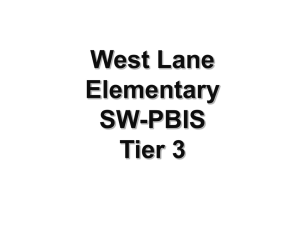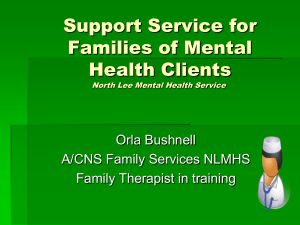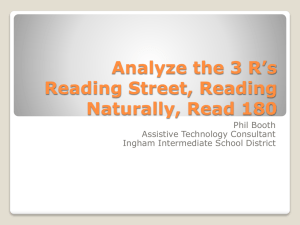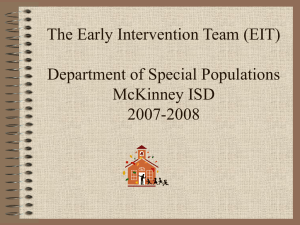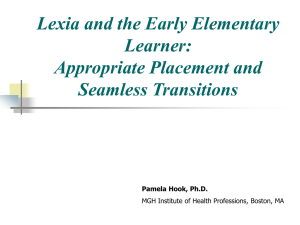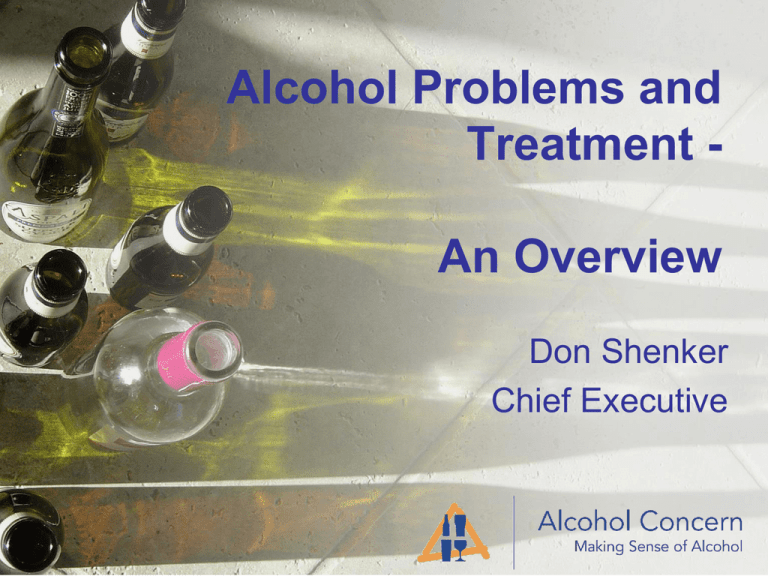
Alcohol Problems and
Treatment An Overview
Don Shenker
Chief Executive
Impact of alcohol
misuse
Financial
Housing
Family and Friends
expense,
unemployment etc
tenancy problems,
complaints etc
Relationship problems,
parental negligence,
abusive behaviour
Workplace
Health
Crime
Absenteeism, accidents
and performance
physical health
and mental health
Greater liklihood of arrest,
drink driving and
domestic violence
Personal Safety
Risky behaviour and
situation
Impact of alcohol dependency on
health services
• 1 in 4 acute male admissions are alcohol
related
• In 11% of cases, alcohol is the main cause
of men’s high blood pressure
• Alcohol is a factor in 48% of all violent
crime
• At peak times 7 out of 10 people attending
A&E have alcohol related problems
• Alcohol misuse costs the NHS £2.7 billion a
year and totals £25Bn pa
Daily guidelines for
sensible drinking:
adults
Recommended ‘sensible drinking’ =
• 2-3 units or less for women
• 3-4 units or less for men
• CMO recommends no alcohol for
under 15s
Department of Health
Units of alcohol
1 unit = half pint beer (3.5%
alcohol)
1 unit = single spirits (25ml @
40% alcohol)
1 unit = 1 glass wine (125 ml @
8% alcohol)
But these are now quite rare!
Government Categories
•
•
•
•
•
•
•
•
•
Lower risk drinkers (who are at a low risk of alcohol-related
illness) are defined as:
Men who don’t regularly drink more than 3 to 4 units a day
Women who don’t regularly drink more than 2 to 3 units a day
Increasing risk drinkers (who are at an increasing risk of
alcohol-related illness) are defined as:
Men who regularly drink more than 3 to 4 units a day but less
than the higher risk levels
Women who regularly drink more than 2 to 3 units a day but
less than the higher risk levels.
Higher risk drinkers (who have high risk of alcohol-related
illness) are defined as:
Men who regularly drink more than 8 units a day or more than
50 units of alcohol per week
Women who regularly drink more than 6 units a day or more
than 35 units of alcohol per week
7
Related health
conditions
Chronic Disorders
• Gastrointestinal
• Cardiovascular
• Neuropsychiatric
conditions
• Cancers
• Admissions:34,000
-91,000
Acute Disorders
• Acute Toxic Effects
• Accidents and
assaults
• Self-inflicted injuries
• Admissions:40,00060,000
Sources: DoH (1995), Gutjahr et al
(2001), Britton and McPherson
(2001)
Alcohol related crime
• Estimated 1.2m incidents of alcohol
related violence
• 80,000 arrests for drunk and
disorderly
• 19,000 sexual assaults related to
alcohol
• 85,000 cases of drink driving
• 360,000 victims of alcohol related
domestic violence
Source: Strategy Unit Interim Analysis (2003)
Alcohol and the family
• Relationship
•
breakdown
• Domestic violence•
and aggression
• Health impacts •
• Poor parenting
• Unsafe sex
•
Marriages twice as
likely to end in divorce
1/3 of divorce
petitions (W.H.O.)
About 2m children
affected by parental
alcohol problem
Between 30-60%
child protection cases
FAST
1. MEN: How often do you have EIGHT or more drinks on
one occasion?
WOMEN: How often do you have SIX or more drinks on
one occasion?
2. How often during the last year have you been unable to
remember what happened the night before because
you had been drinking?
3. How often during the last year have you failed to do what
was normally expected of you because of drinking?
4. In the last year has a relative or friend, or a doctor or
other health worker been concerned about your drinking
or suggested you cut down?
Cycle of change
(Prochaska & DiClemente 1986)
Elements of brief advice:
FRAMES
Feedback about risks of substance use
Responsibility placed on client to
change
Advice to cut down / abstain etc.
Menu of options and choices
Empathic approach
Self-efficacy: using a nonconfrontational counselling style which
encourages & reinforces client’s
strengths
Stepped Care
Approach
Aimed at individuals with a high
level of presenting need.
Inpatient detox and stabilisation,
residential rehab or residential
crisis intervention
Tier 4 a&b
Treatment services
Tier 3
Provide accessible
alcohol specialist services for
a wide range of alcohol misusers
Care planned counselling
Self-help groups
Assertive Outreach
Tier 2
Outreach
Drop in services
Specific advice & information services
Police/CSO
Housing
Primary Care
Solely for misusers in
structured programmes
of care
Tier 1
Services that work with
a wide range of clients
A&E/Walk in Centre/Minor injuries
Types of treatment
•
•
•
•
•
•
•
Advice and information (Tier 2)
Self-help groups (Tier 2)
Care planning counselling (Tier 3)
Structured day programmes (Tier 3)
Community detoxification (Tier 3)
Inpatient treatment (Tier 4)
Residential rehabilitation services (Tier 4)
Thank You
dshenker@alcoholconcern.org.uk
Tel. 020 7264 0510
www.alcoholconcern.org.uk




